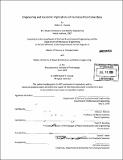Engineering and economic implications of ice-classed containerships
Author(s)
Dvorak, Robert E. (Robert Ernest)
DownloadFull printable version (24.65Mb)
Other Contributors
Massachusetts Institute of Technology. Dept. of Mechanical Engineering.
Advisor
Henry S. Marcus.
Terms of use
Metadata
Show full item recordAbstract
The Arctic is becoming increasingly attractive for shipping. With the potential savings in transit time and the untapped natural resources, both the shipping and offshore industries are pouring capital into research and development. Myriad different ice-classes are described. Every classification society and country has their own system of ice-classing vessels, which leads to complexities within the system. The Polar Rules are looking to harmonize all of the different methods into one set of standards, thus simplifying the process. Also addressed will be the effect of ice-class on vessel design. The hull shape and structure, propulsion machinery, and auxiliary systems are all affected by ice-classing a vessel. Herein, the reader will find a presentation of the percentage increases in weight, power, fuel consumption, and cost of several different ice-classes over conventional containerships. To increase the ice-class slightly, the data is within margins of error and thus, there are no increases (especially with high speed LNG and container vessels). However, to increase the ice-class to the highest class analyzed, the weight, power, fuel consumption, and cost increase substantially. Ice-classed containerships may become economical in the future when the ice cover diminishes due to global warming. Presently, routing containerships over the Arctic is generally not considered by the industry to be economically, politically, or environmentally feasible for continuous, reliable service. This thesis provides insight into the engineering and economic implications of ice-classed containerships.
Description
Thesis (S.M.)--Massachusetts Institute of Technology, Dept. of Civil and Environmental Engineering; and, (S.M. in Naval Architecture and Marine Engineering)--Massachusetts Institute of Technology, Dept. of Mechanical Engineering, 2009. Includes bibliographical references (p. 89-93).
Date issued
2009Department
Massachusetts Institute of Technology. Department of Civil and Environmental Engineering; Massachusetts Institute of Technology. Department of Mechanical EngineeringPublisher
Massachusetts Institute of Technology
Keywords
Civil and Environmental Engineering., Mechanical Engineering.